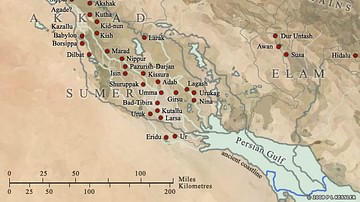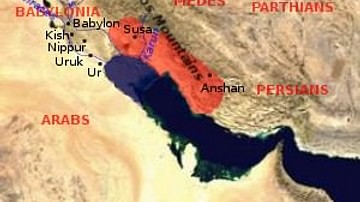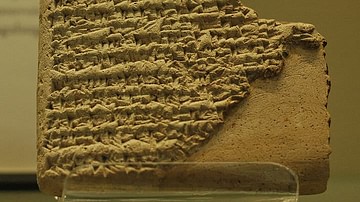Illustration
This map illustrates the rise of the Sumerian city-state of Ur following the collapse of the Akkadian Empire (reign: circa 2334–2154 BCE). In the aftermath of political fragmentation and regional instability, Ur emerged as a leading center of power in southern Mesopotamia. This period, often referred to as the Sumerian Renaissance, marked a revival of Sumerian cultural identity, political organization, and literary production.
Under Ur-Namma (reign: circa 2112–2095 BCE), founder of the Third Dynasty of Ur, and his successor Shulgi (reign: circa 2094–2047 BCE), the Ur III state unified much of Mesopotamia under a centralized bureaucracy. They introduced standardized administrative systems, promoted large-scale temple construction, and supported artistic and intellectual achievements. Ur-Namma’s law code (circa 2100–2050 BCE)—one of the oldest known—reflected early efforts at codified justice. This era marks the final chapter of native Sumerian rule before Mesopotamia entered a new phase of Semitic political dominance.
About the Author
Cite This Work
APA Style
Netchev, S. (2022, March 03). Third Dynasty of Ur c.2050-1950 BCE. World History Encyclopedia. Retrieved from https://www.worldhistory.org/image/15308/third-dynasty-of-ur-c2050-1950-bce/
Chicago Style
Netchev, Simeon. "Third Dynasty of Ur c.2050-1950 BCE." World History Encyclopedia. Last modified March 03, 2022. https://www.worldhistory.org/image/15308/third-dynasty-of-ur-c2050-1950-bce/.
MLA Style
Netchev, Simeon. "Third Dynasty of Ur c.2050-1950 BCE." World History Encyclopedia. World History Encyclopedia, 03 Mar 2022, https://www.worldhistory.org/image/15308/third-dynasty-of-ur-c2050-1950-bce/. Web. 23 Apr 2025.








